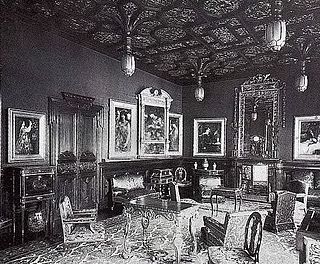
Gabriel Charles Dante Rossetti, generally known as Dante Gabriel Rossetti, was an English poet, illustrator, painter, translator, and member of the Rossetti family. He founded the Pre-Raphaelite Brotherhood in 1848 with William Holman Hunt and John Everett Millais. Rossetti inspired the next generation of artists and writers, William Morris and Edward Burne-Jones in particular. His work also influenced the European Symbolists and was a major precursor of the Aesthetic movement.

Fanny Cornforth was an English artist's model, and the mistress and muse of the Pre-Raphaelite painter Dante Gabriel Rossetti. Cornforth performed the duties of housekeeper for Rossetti. In Rossetti's paintings, the figures modelled by Fanny Cornforth are generally rather voluptuous, differing from those of other models such as Alexa Wilding, Jane Morris and Elizabeth Siddal.
Jerome John McGann is an American academic and textual scholar whose work focuses on the history of literature and culture from the late eighteenth century to the present.

Frederick Richards Leyland was one of the largest British shipowners, running 25 steamships in the transatlantic trade. He was also a major art collector, who commissioned works from several of the Pre-Raphaelite Brotherhood painters.

"The Blessed Damozel" is perhaps the best known poem by Dante Gabriel Rossetti, as well as the title of his painting illustrating the subject. The poem was first published in 1850 in the Pre-Raphaelite journal The Germ. Rossetti subsequently revised the poem twice and republished it in 1856, 1870 and 1873.
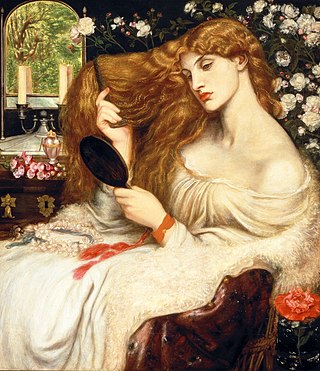
Lady Lilith is an oil painting by Dante Gabriel Rossetti first painted in 1866–1868 using his mistress Fanny Cornforth as the model, then altered in 1872–73 to show the face of Alexa Wilding. The subject is Lilith, who was, according to ancient Judaic myth, "the first wife of Adam" and is associated with the seduction of men and the murder of children. She is shown as a "powerful and evil temptress" and as "an iconic, Amazon-like female with long, flowing hair."
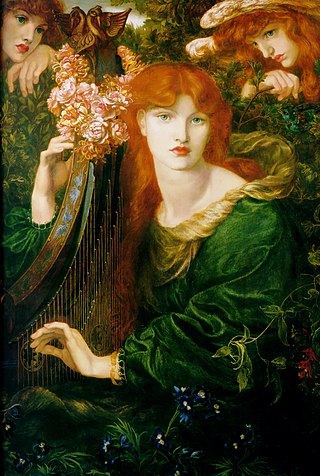
Alexa Wilding was one of the favourite models of the Pre-Raphaelite artist Dante Gabriel Rossetti, featuring in some of his finest paintings of the later 1860s and 1870s. She sat for more of his finished works than any other of his more well-known muses, including Elizabeth Siddall, Jane Morris and Fanny Cornforth.

Found is an unfinished oil painting by Dante Gabriel Rossetti, now in the Delaware Art Museum. The painting is Rossetti's only treatment in oil of a contemporary moral subject, urban prostitution, and although the work remained incomplete at Rossetti's death in 1882, he always considered it one of his most important works, returning to it many times from the mid-1850s until the year before his death.

Ecce Ancilla Domini, or The Annunciation, is an oil painting by the English artist Dante Gabriel Rossetti, first painted in 1850 and now in Tate Britain in London. The Latin title is a quotation from the Vulgate text of the first chapter of the Gospel of Saint Luke, describing the Annunciation, where Mary accepts the message brought to her by the Angel Gabriel that she would give birth to a child (Jesus) by God.
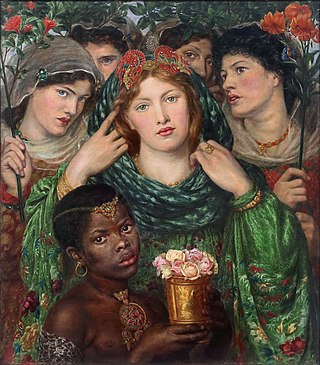
The Beloved is an oil painting on canvas by the English artist Dante Gabriel Rossetti (1828–1882), now in Tate Britain, London. Rossetti signed his initials and the date as "1865-6" on the bottom left of the canvas. It depicts the bride, or "beloved", from the Song of Solomon in the Hebrew Bible as she approaches her bridegroom, with her attendants.

Proserpine is an oil painting on canvas by English artist and poet Dante Gabriel Rossetti, painted in 1874 and now in Tate Britain. Rossetti began work on the painting in 1871 and painted at least eight separate versions, the last only completed in 1882, the year of his death. Early versions were promised to Charles Augustus Howell. The painting discussed in this article is the so-called seventh version commissioned by Frederick Richards Leyland, now at the Tate Gallery, with the very similar final version now at the Birmingham Museum and Art Gallery.

Paolo and Francesca da Rimini is a watercolour by British artist and poet Dante Gabriel Rossetti, painted in 1855 and now in Tate Britain. The painting is a triptych inspired by Canto V of Dante's Inferno, which describes the adulterous love between Paolo Malatesta and his sister-in-law Francesca da Rimini. The left- and right-hand panels both show the lovers together; the central panel shows Dante and the Roman poet Virgil, who guides Dante through hell in the poem.

Mnemosyne, also titled Lamp of Memory and Ricordanza, is an oil painting by Dante Gabriel Rossetti begun in 1875 or early 1876 and completed in 1881. Jane Morris was the model, and Frederick Richards Leyland bought the painting in 1881 and displayed it in his drawing room with five other Rossetti "stunners." At about the same time Rossetti, a founder of the Pre-Raphaelite Brotherhood, was painting Astarte Syriaca, a larger painting completed in 1877 with Morris in a very similar pose.

Veronica Veronese is an oil painting by Dante Gabriel Rossetti painted in 1872 with Alexa Wilding as the model. The painting was conceived as a companion to Lady Lilith. Rossetti sold the painting to one of his best clients, shipping magnate Frederick Richards Leyland. In 1923 it was acquired by the estate of Samuel Bancroft which donated it in 1935 to the Delaware Art Museum.

Water Willow is an 1871 oil painting by Dante Gabriel Rossetti. It depicts Jane Morris in the river landscape near Kelmscott Manor, with the manor in the left background and Kelmscott Church below the hill to the right.

Rose and Silver: The Princess from the Land of Porcelain is an oil painting on canvas by American-born artist James McNeill Whistler. It was painted between 1863 and 1865. It currently hangs above the fireplace in The Peacock Room at the Freer Gallery of Art in Washington, D.C.
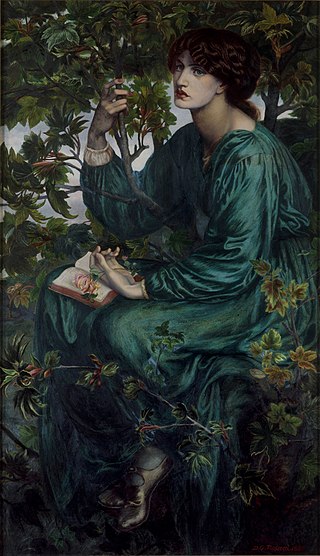
The Day Dream or, as it was initially intended to be named, Monna Primavera, is an oil-on-canvas painting by the Pre-Raphaelite Brotherhood founder member Dante Gabriel Rossetti. The work, which measures 158.7 centimetres (62.5 in) high by 92.7 centimetres (36.5 in) wide, was undertaken in 1880 and depicts Jane Morris in a seated position on the bough of a sycamore tree. In her hand is a small stem of honeysuckle – a token of love in the Victorian era – that may be an indication of the secret affair the artist was immersed in with her at the time. The artwork was left to the Victoria and Albert Museum by Constantine Alexander Ionides in 1900.

A Sea-Spell is an oil painting of 1877 and an accompanying sonnet of 1869 by the English artist Dante Gabriel Rossetti, depicting a siren playing an instrument to lure sailors. It is now in the Harvard Art Museums in Cambridge, Massachusetts.

La Ghirlandata("The Garlanded Woman") is an 1873 painting by English painter and poet Dante Gabriel Rossetti Dante Gabriel Rossetti. It is currently in the collection of the Guildhall Art Gallery in London, United Kingdom. The model who sat for the painting was Alexa Wilding. May Morris was the model for both angel heads in the top corners of the painting.
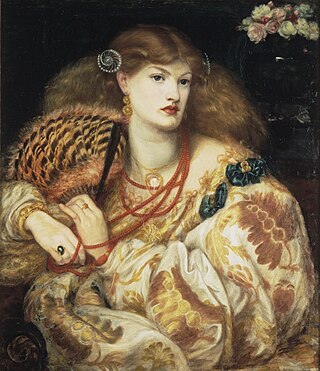
Monna Vanna is an 1866 oil on canvas painting by Dante Gabriel Rossetti. It was acquired by the collector William Henry Blackmore and later entered the collection of George Rae, one of Rossetti's patrons. It later passed from Rae to the joint ownership of Arthur Du Cros and Otto Beit and it was purchased from them by the Tate Gallery in 1916 via the NACF – it is now in the collection of Tate Britain in London.


